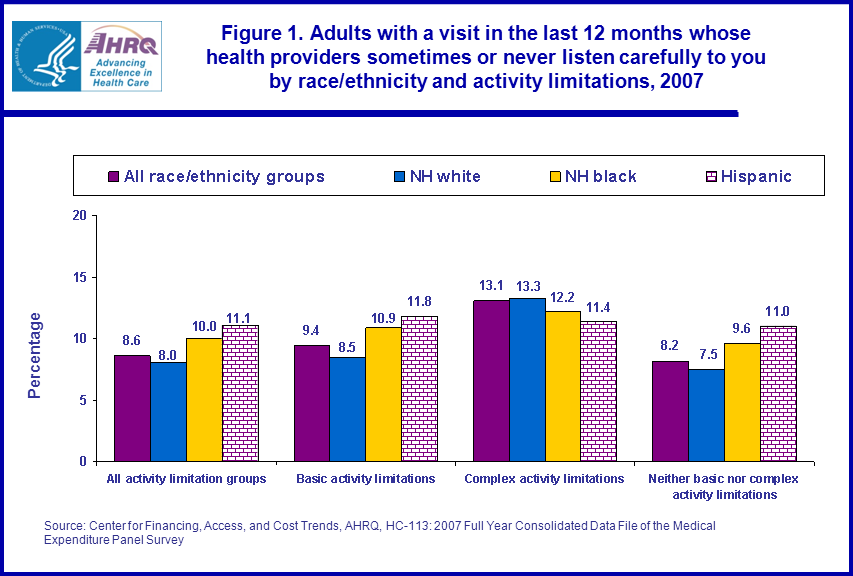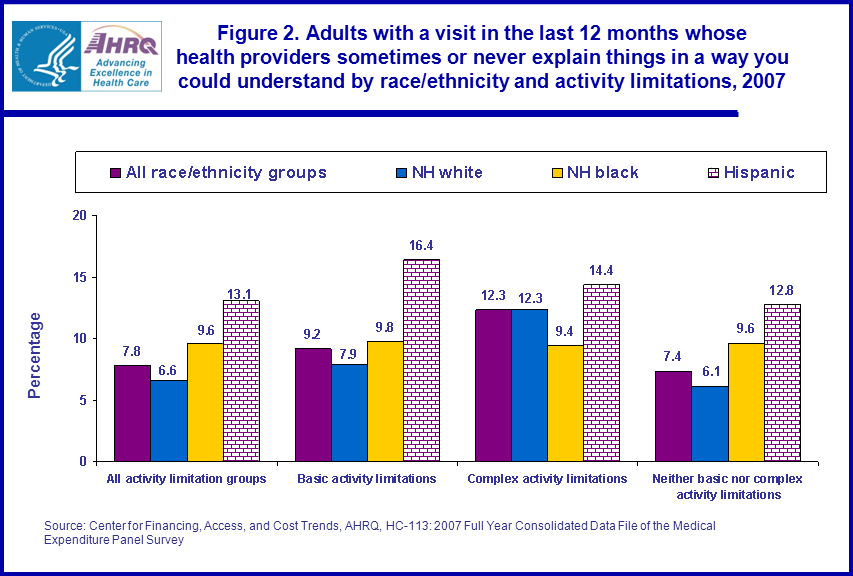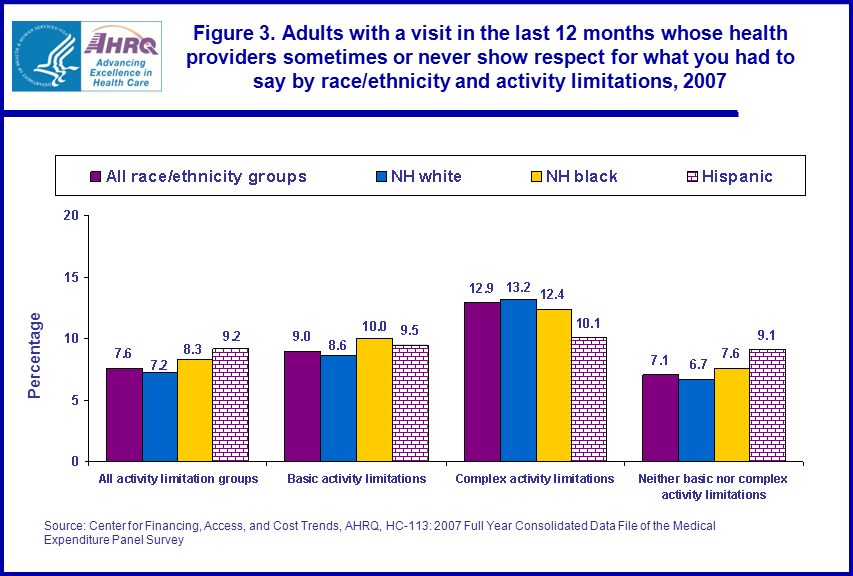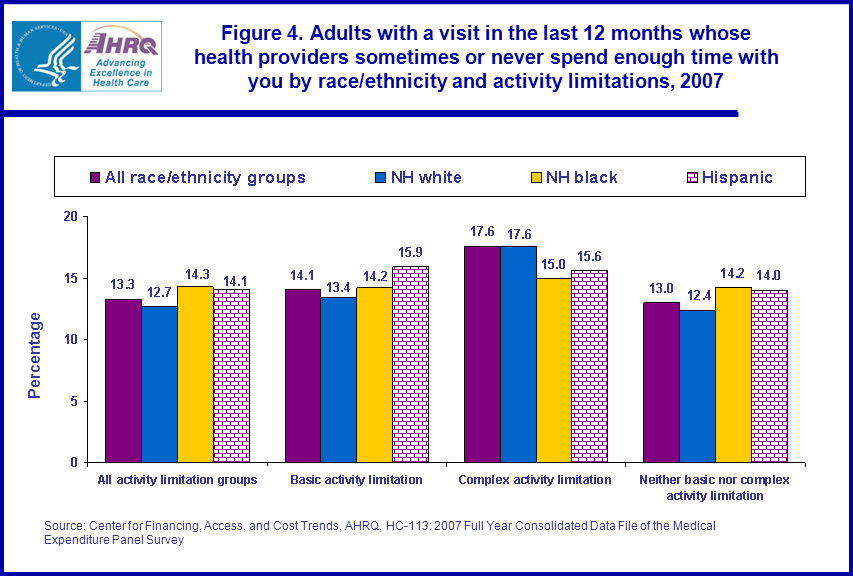
|
|
Font Size:
|
||||
|
|
|
|
||||
STATISTICAL BRIEF #312:
Patient-Provider Communication by Race/Ethnicity and Disability Status: United States, 2007
Highlights
- In 2007, adults with complex activity limitations were more likely than adults with basic activity limitations or adults with neither to report problems with communication across all four measures, for all race/ethnicity groups combined.
- Adults with basic activity limitations were more likely than adults with neither to report problems with communication in two measures "Explain things in a way you could understand" and "Show respect for what you had to say," for all race/ethnicity groups combined.
- For non-Hispanic white adults, those with complex activity limitations were more likely than those with basic activity limitations or with neither to report problems with communication across all four measures.
- Hispanic adults were more likely than non-Hispanic white adults to report problems with communication in three measures "Listen carefully to you," "Explain things in a way you could understand," and "Show respect for what you had to say," for all activity limitation groups combined.
- Non-Hispanic black adults were more likely than non-Hispanic white adults to report problems with communication in two measures "Listen carefully to you" and "Explain things in a way you could understand," for all activity limitation groups combined.
- For adults with neither basic nor complex activity limitations, Hispanic adults were more likely than non-Hispanic white adults to report problems with communication in three measures "Listen carefully to you," "Explain things in a way you could understand," and "Show respect for what you had to say."
Introduction
Patient centered care is an important aspect of quality health care1 and is supported by good provider-patient communication. The provider-patient communication measures used in this report are part of the health care quality measures taken from the health plan version of Consumer Assessment of Healthcare Providers and Systems (CAHPS®), an AHRQ sponsored family of survey instruments designed to measure quality of care from the consumer's perspective. This Statistical Brief augments the analyses in the 2010 National Healthcare Quality and Disparities Reports2 (NHQR/DR) by analyzing provider-patient communication by race/ethnicity stratified by disability status for the following four measures—health providers who sometimes or never: listen carefully to you; explain things in a way you could understand; show respect for what you had to say; and, spend enough time with you. The Patient Centeredness chapters of the 2010 NHQR/DR contain analysis for the composite measure that combines these four measures of provider-patient communication into a single core measure.Estimates in this report are presented by race/ethnicity and disability status as measured by activity limitations. The disability measures used in this report have been used in the NHQR/DR since 2007. Adults with disabilities are defined to be those with a physical, sensory, and/or mental health condition that can be associated with a decrease in functioning in such day-to-day activities as bathing, walking, doing everyday chores, and/or engaging in work or social activities. In displaying the data on disability, paired measures are used to preserve the qualitative aspects of the data. The first measure, limitations in basic activities, represents problems with mobility and other basic functioning at the person level. The second measure, limitations in complex activities, represents limitations encountered when the person, in interaction with his or her environment, attempts to participate in community life. These two measures are not mutually exclusive since persons may have limitations both in basic activities and in complex activities. The residual category neither includes adults with neither basic nor complex activity limitations.3
The estimates are derived from the Household Component of the Medical Expenditure Panel Survey (MEPS-HC). Unless otherwise indicated, all differences discussed in the text are statistically significant at the .05 level or better.
Findings
In 2007, adults who had a doctor's office or clinic visit in the last 12 months whose health providers listen carefully to youIn 2007, approximately 1 in 12 adults (8.6 percent) in the U.S. civilian noninstitutionalized population with a doctor's office or clinic visit in the last 12 months reported problems with communication for this measure (health providers sometimes or never listen carefully to you) (figure 1). Overall for all race/ethnicity groups combined, adults with complex activity limitations were more likely to report problems with communication than those with basic activity limitations or those with neither (13.1 percent for adults with complex activity limitations compared with 9.4 percent for adults with basic activity limitations and 8.2 percent for adults with neither). This same pattern holds for non-Hispanic whites (13.3 percent for those with complex activity limitations compared with 8.5 percent for those with basic activity limitations and 7.5 percent for those with neither).
Overall for all activity limitation groups combined, Hispanic adults and non-Hispanic black adults were more likely than non-Hispanic white adults to report problems with communication for this measure. This same pattern of Hispanic and non-Hispanic black adults being more likely than non-Hispanic white adults to report problems with communication holds for adults with neither basic nor complex activity limitations. Among adults with neither, non-Hispanic black adults (9.6 percent) and Hispanic adults (11.0 percent) were more likely than non-Hispanic white adults (7.5 percent) to report problems with communication for this measure.
In 2007, adults who had a doctor's office or clinic visit in the last 12 months whose health providers explain things in a way you could understand
Approximately 1 in 13 adults (7.8 percent) with a doctor's office or clinic visit in the last 12 months reported problems with communication for this measure (health providers sometimes or never explain things in a way you could understand) (figure 2). Overall for all race/ethnicity groups combined, adults with complex activity limitations (12.3 percent) were more likely than adults with basic activity limitations (9.2 percent); and, adults with basic activity limitations (9.2 percent) were more likely than adults with neither (7.4 percent) to report problems with communication. For non-Hispanic white adults, those with complex activity limitations were more likely than those with basic activity limitations or those with neither to report problems with communication for this measure (12.3 percent for complex activity limitations compared with 7.9 percent for basic activity limitations and 6.1 percent for neither).
Overall for all activity limitation groups combined, Hispanic adults (13.1 percent) and non-Hispanic black adults (9.6 percent) were significantly more likely than non-Hispanic white adults (6.6 percent) to report problems with communication for this measure. This same pattern of higher percentages for Hispanic adults and non-Hispanic black adults than for non-Hispanic white adults holds for persons with neither basic nor complex activity limitations. Among adults with neither basic nor complex activity limitations, non-Hispanic black adults (9.6 percent) and Hispanic adults (12.8 percent) were more likely than non-Hispanic white adults (6.1 percent) to report problems with communication. Among adults with basic activity limitations, Hispanic adults (16.4 percent) were more likely than non-Hispanic white adults (7.9 percent) to report problems with communication.
In 2007, adults who had a doctor's office or clinic visit in the last 12 months whose health providers show respect for what you had to say
Approximately 1 in 13 adults (7.6 percent) with a doctor's office or clinic visit in the last 12 months reported problems with communication for this measure (health providers sometimes or never show respect for what you had to say) (figure 3). Overall for all race/ethnicity groups combined, adults with complex activity limitations (12.9 percent) were more likely than adults with basic activity limitations (9.0 percent); and, adults with basic activity limitations (9.0 percent) were more likely than adults with neither (7.1 percent) to report problems with communication. For non-Hispanic whites, adults with complex activity limitations (13.2 percent) were more likely than those with basic activity limitations (8.6 percent) or with neither (6.7 percent) to report problems with communication.
Overall for all activity limitation groups combined, Hispanic adults (9.2 percent) were more likely than non-Hispanic white adults (7.2 percent) to report problems with communication. This same pattern holds for adults with neither basic nor complex activity limitations (9.1 percent for Hispanics with neither basic nor complex activity limitations compared with 6.7 percent for non-Hispanic whites with neither basic nor complex activity limitations).
In 2007, adults who had a doctor's office or clinic visit in the last 12 months whose health providers spend enough time with you
Approximately 1 in 7.5 adults (13.3 percent) with a doctor's office or clinic visit in the last 12 months reported problems with communication for this measure (health providers sometimes or never spend enough time with you) (figure 4). Overall for all race/ethnicity groups combined, adults with complex activities limitations were more likely than those with basic activity limitations or with neither to report problems with communication for this measure (17.6 percent for adults with complex activity limitations compared with 14.1 percent for adults with basic activity limitations and 13.0 percent for adults with neither.) This same pattern holds for non-Hispanic whites (17.6 percent for non-Hispanic whites with complex activity limitations compared with 13.4 percent for non-Hispanic whites with basic activity limitations and 12.4 percent for non-Hispanic whites with neither.)
There are no significant differences by race/ethnicity in adults reporting that their health providers sometimes or never spend enough time with you overall for all the activity limitation groups combined or within any of the three activity limitation groups (basic activity limitations, complex activity limitations, neither).
Data Source
The estimates in this Statistical Brief are based on data from the MEPS HC-113: 2007 Full Year Consolidated Data File.Definitions
Provider-patient communicationThe four provider-patient communication measures are health providers who: listen carefully to you; explain things in a way you could understand; show respect for what you had to say; and, spend enough time with you. There are four response categories for each of the four questions associated with these measures: Never, Sometimes, Usually, and Always. Percentages in this report are for the combination of the Never and Sometimes response categories and which we refer to as problems with communication. The four measures are part of the health care quality measures taken from the health plan version of CAHPS®, an AHRQ sponsored family of survey instruments designed to measure quality of care from the consumer's perspective. The questions are asked in the Self-Administered Questionnaire (SAQ) distributed to all adults in Rounds 2 and 4 of the MEPS Household Component.
Adult
For this report, adult refers to persons ages 18 and over where age is determined at the time of the Rounds 2 and 4 interviews (rounds in which the SAQ was distributed).
Race/ethnicity
Classifications by race/ethnicity in this report are based on the following three race/ethnicity groups: white single race non-Hispanic; black single race non-Hispanic; and Hispanic. Classification by race and ethnicity is based on information reported in MEPS for each family member. First, respondents were asked if the person's main national origin or ancestry was Puerto Rican; Cuban; Mexican, Mexican American, or Chicano; Other Latin American; or other Spanish. All persons whose main national origin or ancestry was reported as one of these Hispanic groups, regardless of racial background, were classified as Hispanic. All other persons were classified according to their reported race. The residual category that includes non-Hispanics of other races or multiple races is not shown. Comparisons are made to non-Hispanic whites.
Adult disability status as measured by activity limitations
There are many ways to measure disability. The measures used here are those used in the NHQR/DR and are based on the work of an interagency work group that was instituted to provide a measure of disability as consistent and compatible as possible across all the data sets used in the NHQR/DR. For the purpose of the NHQR/DR and of this report, adults with disability are defined to be those with a physical, sensory, and/or mental health condition that can be associated with a decrease in functioning in such day-to-day activities as bathing, walking, doing everyday chores, and/or engaging in work or social activities. In displaying the data on disability, the work group recommended using paired measures to preserve the qualitative aspects of the data. The first measure, limitations in basic activities, represents problems with mobility and other basic functioning at the person level. The second measure, limitations in complex activities, represents limitations encountered when the person, in interaction with his or her environment, attempts to participate in community life. Limitations in basic activities includes problems with: mobility; self-care (activities of daily living); domestic life (instrumental activities of daily living); and activities dependent on sensory functioning (limited to persons who are blind or deaf). Complex activities include limitations experienced in work and in community, social, and civic life. These two categories are not mutually exclusive since persons may have limitations both in basic activities and in complex activities. The residual category neither includes adults with neither basic nor complex activity limitations.3
About MEPS-HC
The MEPS Household Component (MEPS-HC) is a nationally representative longitudinal survey that collects detailed information on health care utilization and expenditures, health insurance, and health status, as well as a wide variety of social, demographic, and economic characteristics for the U.S. civilian noninstitutionalized population. It is cosponsored by the Agency for Healthcare Research and Quality and the National Center for Health Statistics.For more information about MEPS, call the MEPS information coordinator at AHRQ (301) 427-1656 or visit the MEPS Web site at http://www.meps.ahrq.gov/.
References
For a detailed description of the MEPS-HC survey design, sample design, and methods used to minimize sources of nonsampling error, see the following publications:Cohen, J. Design and Methods of the Medical Expenditure Panel Survey Household Component. MEPS Methodology Report No. 1. AHCPR Pub. No. 97-0026. Rockville, MD: Agency for Health Care Policy and Research, 1997. http://www.meps.ahrq.gov/mepsweb/data_files/publications/mr1/mr1.shtml
Cohen, S. Sample Design of the 1996 Medical Expenditure Panel Survey Household Component. MEPS Methodology Report No. 2. AHCPR Pub. No. 97-0027. Rockville, MD: Agency for Health Care Policy and Research, 1997. http://www.meps.ahrq.gov/mepsweb/data_files/publications/mr2/mr2.shtml
Cohen, S.B. Sample Design of the 1997 Medical Expenditure Panel Survey Household Component. Rockville, MD: Agency for Healthcare Research and Quality, 2000. MEPS Methodology Report No. 11, AHRQ Pub. No. 01-0001. http://www.meps.ahrq.gov/mepsweb/data_files/publications/mr11/mr11.shtml
Cohen, S. Design Strategies and Innovations in the Medical Expenditure Panel Survey. Medical Care, July 2003: 41(7) Supplement: III-5—III-12.
Ezzati-Rice, T.M., Rohde, F., Greenblatt, J. Sample Design of the Medical Expenditure Panel Survey Household Component, 1998-2007. Methodology Report No. 22. March 2008. Agency for Healthcare Research and Quality, Rockville, MD. http://www.meps.ahrq.gov/mepsweb/data_files/publications/mr22/mr22.shtml
Suggested Citation
Chevarley, F.M. Patient-Provider Communication by Race/Ethnicity and Disability Status: United States, 2007. Statistical Brief #312. February 2011. Agency for Healthcare Research and Quality, Rockville, MD. http://www.meps.ahrq.gov/mepsweb/data_files/publications/st312/stat312.shtmlAHRQ welcomes questions and comments from readers of this publication who are interested in obtaining more information about access, cost, use, financing, and quality of health care in the United States. We also invite you to tell us how you are using this Statistical Brief and other MEPS data and tools, and to share suggestions on how MEPS products might be enhanced to further meet your needs. Please e-mail us at mepspd@ahrq.gov or send a letter to the address below:
Steven B. Cohen, PhD, Director
Center for Financing, Access, and Cost Trends
Agency for Healthcare Research and Quality
540 Gaither Road
Rockville, MD 20850
1 Institute of Medicine Committee on Quality of Health Care in America. Crossing the Quality Chasm: A New Health System for the 21st Century. Washington, DC: National Academy Press; 2001.
2 Agency for Healthcare Research and Quality. 2010 National Healthcare Quality Report/2010 National Healthcare Disparities Report. Rockville, MD: U.S. Department of Health and Human Services, Agency for Healthcare Research and Quality: (Publication date: February 2011)
3 Agency for Healthcare Research and Quality. 2007 National Healthcare Disparities Report. Rockville, MD: U.S. Department of Health and Human Services, Agency for Healthcare Research and Quality: February 2008. http://www.ahrq.gov/qual/qrdr07.htm
 |
|||||||||||||||||||||||||||||||||||
|
|||||||||||||||||||||||||||||||||||
|
|
|||||||||||||||||||||||||||||||||||
 |
|||||||||||||||||||||||||||||||||||
|
|||||||||||||||||||||||||||||||||||
|
|
|||||||||||||||||||||||||||||||||||
 |
|||||||||||||||||||||||||||||||||||
|
|||||||||||||||||||||||||||||||||||
|
|
|||||||||||||||||||||||||||||||||||
 |
|||||||||||||||||||||||||||||||||||
|
|||||||||||||||||||||||||||||||||||
|
|
|||||||||||||||||||||||||||||||||||


